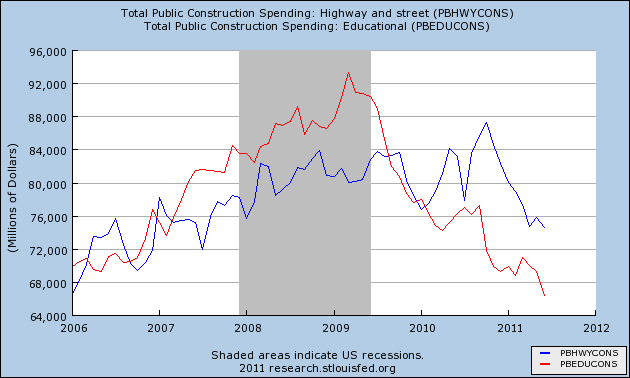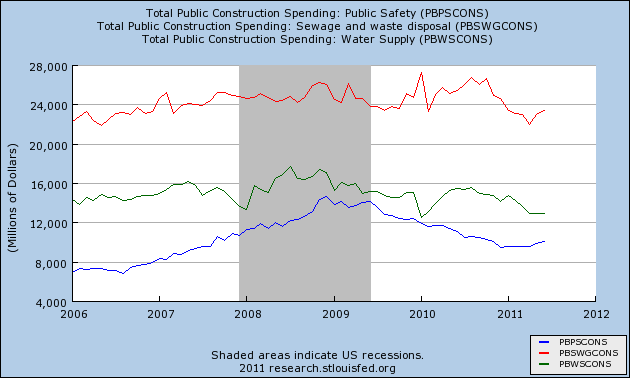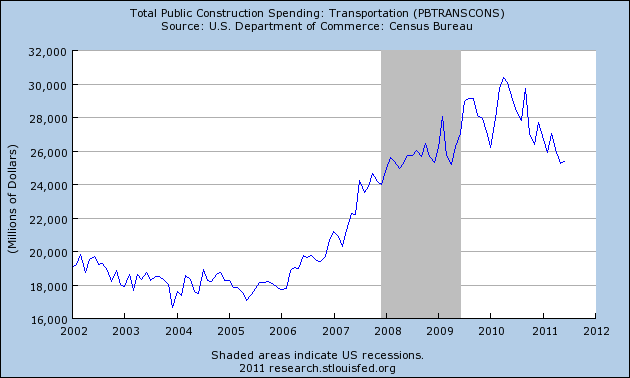Obama had one shot at a stimulus package when the economy was reeling from the near economic collapse of 2008. Some members of his team argued it needed to be bigger (it did), but for whatever reasons they did not prevail. What was needed then — as now — was to put money to work in such a way as to get the best bang for the buck and put as many people to work as possible. It’s been my long-held contention that infrastructure would have been an ideal use of stimulus funds. Consider (much more data at the link):
With 45 percent of roads in less than good condition and 12 percent of bridges structurally deficient, the U.S. faces severe infrastructure needs that significantly impact the nation’s economy.
More than 150,000 miles—or 45 percent—of federal highways and major roads in the U.S. are not in good condition, according to the Federal Highway Administration. More than 71,000 of the nation’s bridges—12 percent—are rated as structurally deficient. More than 78,000 are rated as functionally obsolete. More than 20 states this year will likely reduce transportation investments because of federal inaction on a new surface transportation authorization bill.
So, perhaps we could have used some money to give our highways and streets some needed attention. Other areas that come to my mind as good candidates for construction are: Public Safety, Sewage & Waste Disposal, Water Supply, and Educational. Sadly, it seems as though not much money went to these necessities. Thanks to some data sets recently picked up by FRED, we can take a look at all of these areas. First up, Highway & Street and Educational construction spending. What I’d really like to see here is a spike — a big one — which would indicate stimulus funds had been allocated to these crucial areas. Do you see a meaningful spike? Neither do I, and what’s worse is that both series are now on the decline.
(NOTE: These expenditures all have to do solely with construction spending)
Let’s look at the other areas I mentioned (I broke the data into multiple charts to keep similar dollar expenditure levels together and thereby render greater detail).
No signs of a meaningful spike here, either.
One last look, this time at Transportation (like, say, the high speed rail I’ve always hoped Obama would embrace):
So, nothing significant has really been done on any of these files, and now Obama’s out of bullets. The beauty of construction spending is that you wind up with things — roads, bridges, tunnels, rails, schools, sewage treatment plants, power plants, airports, dams — that last for decades and get passed from one generation to the next. Now that opportunity has been squandered — DC is in full-on austerity mode, and the states and municipalities are having their own issues.
I wrote in June 2010: “And, for the record, I’ll state here that I think Obama and his team badly misallocated the stimulus in ways that did little to create jobs, unarguably its most important objective. And that will cost him dearly (as evidenced by yesterday’s third defeat of an unemployment benefits extension?).” Nothing that has happened in the past 14 months has caused me to waver from that position.
Final note: As I was wrapping up this post, I received an alert that the Philly Fed’s Leading Index series had been updated, so of course I took a gander. The contours of our two “soft patches” are clear. The difference is that last year at this time The Bernank was announcing QE2. It remains to be seen whether or not Ben has another rabbit to pull out of another hat.
UPDATING, Aug 3, 10:24AM: In his daily today, David Rosenberg makes the same point regarding the stimulus:
The overhang of excessive debt burdens is still with us today and the problem with the government stimulus programs that were put into place is that they were not designed properly; the multiplier impacts never did kick in. So we can’t “grow” our way out.






What's been said:
Discussions found on the web: